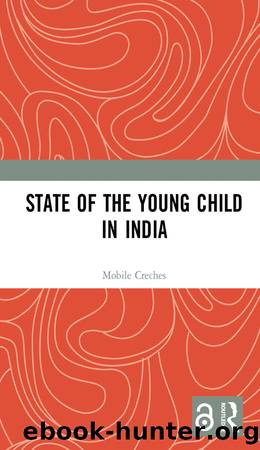State of the Young Child in India by Mobile Creches

Author:Mobile Creches [Creches, Mobile]
Language: eng
Format: epub
Tags: Social Science, General, Medical, Public Health, Children's Studies, Anthropology
ISBN: 9781000054934
Google: 3ZvSDwAAQBAJ
Barnesnoble:
Goodreads: 49130408
Publisher: Taylor & Francis
Published: 2020-02-24T01:39:37+00:00
4.3.2 The girl child faces gendered forms of deprivation and neglect
Gender inequality is an important root cause of childrenâs poor development in the early years.18 In India, the girl child is often considered as a liability, whereas boys are given the exclusive rights to inherit the family name and they are viewed as additional status for their family (Jha and Nagar, 2015). In many parts of India, the birth of a girl child is not welcomed, this discrimination starts from even before the birth. She is killed as a foetus or later as an infant, which results in highly skewed child sex ratio in favour of boys in India. Indeed, declining CSR is a potent indicator of female disempowerment. Post-birth discrimination against girls is reflected in neglect in the intra-household distribution of food, nutrition and healthcare.
India currently faces declining sex ratio at birth (SRB) and adverse CSR as a result of systemic gender discrimination and ranks poorly in Human Development and Gender Index, as shown in Box 4.4. It is symptomatic of a patriarchal society that prefers sons over daughters and neglects girls at every stage and in various arenas.
Box 4.4Benchmarking gender inequities and inequalities
India ranks 130 among 189 countries with a Human Development Index (HDI) value of 0.640 in the UNDP Human Development Report 2018. It marked nearly 50 percent increase from 0.427 in 1990 due to the achievement in poverty alleviation. Between 1990 and 2017, Indiaâs life expectancy at birth too increased by nearly eleven years, with even more significant gains in expected years of schooling. Indian school-age children can now expect to stay in school for 4.7 years longer than in 1990, whereas Indiaâs GNI per capita increased by a staggering 266.6 percent between 1990 and 2017.
However, India is ranked 95 with a score of 56.2 among 129 countries in the SDG Gender Index 2019 that measures global gender equality. The index takes into account 14 out of 17 SDGs that cover aspects such as poverty, health, education, literacy, political representation and equality at the workplace.19 A score of 100 reflects the achievement of gender equality in relation to the targets set for each indicator. It means, for example, that 100 percent of girls complete secondary education, or that there is around 50â50 parity for women and men in Parliament. A score of 50 signifies that a country is about halfway to meeting a goal.20
The Human Capital Index (World Bank, 2018) has given India a score of 0.44 out of a total of 1.0, lower than the average for its income level countries. Simply put, children born in India today are likely to be only 44 percent as productive when they grow up, compared to a scenario if they enjoyed equal opportunities in education and health.
(Human Development Report, 2018; Equal Measures 2030, 2019; Human Capital Index, 2018)
Download
This site does not store any files on its server. We only index and link to content provided by other sites. Please contact the content providers to delete copyright contents if any and email us, we'll remove relevant links or contents immediately.
Cecilia; Or, Memoirs of an Heiress — Volume 1 by Fanny Burney(32054)
Cecilia; Or, Memoirs of an Heiress — Volume 3 by Fanny Burney(31453)
Cecilia; Or, Memoirs of an Heiress — Volume 2 by Fanny Burney(31402)
The Great Music City by Andrea Baker(30778)
We're Going to Need More Wine by Gabrielle Union(18626)
All the Missing Girls by Megan Miranda(14709)
Pimp by Iceberg Slim(13771)
Bombshells: Glamour Girls of a Lifetime by Sullivan Steve(13680)
Fifty Shades Freed by E L James(12908)
Talking to Strangers by Malcolm Gladwell(12864)
Norse Mythology by Gaiman Neil(12819)
For the Love of Europe by Rick Steves(11432)
Crazy Rich Asians by Kevin Kwan(8883)
Mindhunter: Inside the FBI's Elite Serial Crime Unit by John E. Douglas & Mark Olshaker(8697)
The Lost Art of Listening by Michael P. Nichols(7157)
Enlightenment Now: The Case for Reason, Science, Humanism, and Progress by Steven Pinker(6869)
The Four Agreements by Don Miguel Ruiz(6310)
Bad Blood by John Carreyrou(6271)
Weapons of Math Destruction by Cathy O'Neil(5824)
